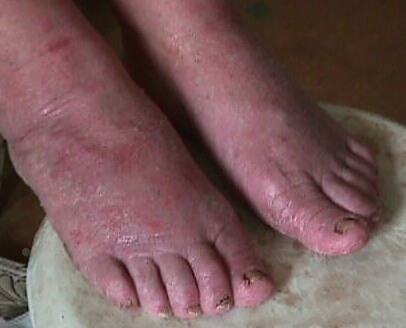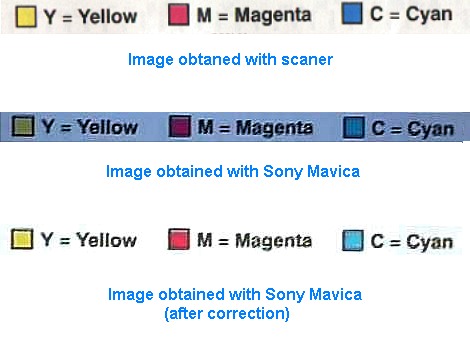Occupational Health - Public Health Poster Session
| INABIS '98 Home Page | Your Session | Symposia & Poster Sessions | Plenary Sessions | Exhibitors' Foyer | Personal Itinerary | New Search |
INTRODUCTION
It is very important to support availability of medical services in the field of occupational medicine at adequate level; otherwise health care authorities cannot provide proper revealing and treatment of occupational pathology in the workers of industrial enterprises.
Research Institute of Hygiene and Occupational Pathology (Nizhny Novgorod, Russia) is responsible for environmental and occupational health at rather large territory. The activity of the Institute covers area of 450000 sq. km with population about 10.1 mln - Nizhny Novgorod, Vladimir and Kirov regions, as well as three national republics within Russian Federation - Mariy El, Chuvashian and Mordovian Republics. Often the patients with presumed occupational diseases should sometimes cover up to 500 km to reach the clinic of Institute where occupational pathology can be officially recognized. To confirm the connection between pathology and occupation, it is important to have official documents concerning patient's previous place of work. It is often hard to obtain such documents in reasonable time (e.g. during the period of patient's hospitalization).
Nowadays, in time of financial crisis in Russia, to make a 500-km trip can be too expensive for some categories of Russian workers. It results in dramatic decrease of the amount of patients from distant places in the clinic of the Institute. For example, in 1997 about 60% of all patients with occupational diseases were from Nizhny Novgorod itself. But the population of Nizhny Novgorod is only about 15% of the population of all the territory for which the Institute is responsible. Thus, it can be concluded that the prevalence of occupational diseases in distant places of the large territory seems to be significantly underestimated, due to low availability of specialists in occupational pathology in remote regions.
The hardest situation is in the field of occupational dermatology, where only one specialist has to serve for all the large territory with 10-million population. It also leads to decrease in recognition of occupation skin pathology. It should be mentioned, that In 1997 the incidence of recognized occupational skin pathology in the territory of responsibility was about 10 times less than in 1980s.
One of the possible ways to improve the quality and availability of medical service in the field of occupational dermatology (without hiring dozens of dermatologists) can be implementation of telemedical service.
POSSIBLE USE OF TELEMEDICINE
Telemedicine, or "remote communication of information to facilitate clinical care" [1], allows improving medical service for the population of remote regions, where the direct consultation of some medical specialist happens to be complicated or impossible. The availability of telephone communication, computer and devices for input of medical information makes possible to perform telemedical consultations with any expert, located practically in any point of the world. The introduction of new telemedical technologies will often allow lowering the charges on qualified medical service at the remote territories [2, 5]. The telemedical technologies are widely used now in Northern America, in Scandinavian countries, in Southeast Asia.
Dermatology is the branch of medicine, where telemedical technologies are applied perhaps the most widely. The image of affected skin can be easily obtained and transferred via telecommunication systems, it contains a significant part of information needed to make a correct diagnosis in dermatology. As it was shown in specially performed researches in many countries, the correct diagnosis can be made using teledermatology in more than 70 % of cases [3, 4, 5]. The use of telemedical technologies in dermatology can be most actual for Russian regions, as in this case it is enough to transfer the stationary image of skin lesion, along with anamnestical data. Such information can be easily transferred without ISDN connections, but just through usual telephone lines practically of any quality, which allow Internet connection at 28.8 kbps.
USE OF TELEMEDICINE IN OCCUPATIONAL DERMATOLOGY
According to the present situation, the use of telemedicine in Nizhny Novgorod region can be especially actual for occupational dermatology.Telemedical consultations on occupational dermatology can diminish the need to trip to regional center of occupational pathology for most of patients. Now Nizhny Novgorod Research Institute of Hygiene and Occupational Pathology actively introduces Internet technologies, that will allow organizing regional (and later - interregional) network of telemedical diagnostics of occupational skin diseases. Certainly, this structure can be used also for consultations of the patients with complicated cases of general skin diseases. The patients from Nizhny Novgorod and from the whole region can also be consulted with leading Moscow dermatologists (in Dermatovenereology Chair of Moscow Medical and Stomatological Institute).
Nowadays Research Institute of Hygiene and Occupational Pathology has got the first experience in telemedical examinations of patients with presumed occupational skin diseases. The connection was established between dermatological department of Bor District Hospital (about 10 km from Nizhny Novgorod) and the clinic of Institute in Nizhny Novgorod. The images of affected skin were obtained using digital camera Sony Mavica FD-71(resolution 640x480 pixels, 24-bit color). The sample image is shown below (mycotic eczema):
 Figure 1
Figure 1
The JPEG files (about 100 kB) can be transferred using email, or Microsoft NetMeeting can be used to transfer images along with text documents.
Due to financial crisis, prices for Internet connection in Russia (usually rated in US dollars) became comparable with tariffs for long distance telephone calls (rated in rubles). For example, the lowest tariffs for telephone calls from Bor District Hospital to Nizhny Novgorod are from 0.6 to 1.2 rubles per minute (36-72 rubles per hour), while Internet connection tariffs in Bor can be as high as 4-5 USD per hour (64-80 rubles). Thus, it can expected that even Internet connection at 28.8 kbps would be too expensive for health care organizations and mainly direct connections via long-distance telephone lines will be used to transfer medical information.
Unfortunately, modern law system in Russia does not allow using electronic documents in cases concerning questions of financial compensation etc. So it is needed to confirm all the electronic data with hard copies of the same documents. But there is a hope that situation will be changed soon, because technologies of authorization and encryption of electronic documents become more and more perfect. Good example of use of these technologies can be found in sphere of banking.
According to the available information concerning the experience of foreign dermatologists, telemedical diagnostics does have some restrictions. In 25-30 % of cases remote diagnosis had appeared to be inexact or incorrect [3, 4]. Therefore, the final diagnosis of occupational skin diseases will certainly be made only at face-to-face examination. Moreover, at the first stage of introduction of a telemedical system each case diagnosed remotely should be verified through direct contact of the doctor and the patient. Nevertheless, even at the first stage of introduction of the system it will be possible to fasten the delivery of the necessary documents from district hospitals to the occupational dermatologist to Nizhny Novgorod via email instead of simple mail, used now.
Being implemented, the system of medical data transfer in the field of occupational pathology may also be used to evaluate the risk of occupational skin diseases in individual workers. A computer expert system "Predict" was elaborated in the Institute for such evaluation. Now only desktop version of the system is available, which can help evaluating the risk of allergic contact dermatitis in workers handling chemical allergens (e.g. epoxy resins) [6]. The on-line version of the system will be available at website of the Institute soon.
THE QUALITY OF IMAGES TO BE USED IN TELEDERMATOLOGY
The quality of images obtained with Mavica FD-71 was generally acceptable, but resolution of the images perhaps should be higher (not less than 1 mln. pixels totally). Some instability in reproduction of standard color test was found. For example, the level of red was constantly and significantly (about 80%) lower, which made images tinged with blue. This tinge was stable and could be corrected using proper software (The colors of above shown image was corrected). But the proportion of green component was unpredictable and could vary ± 30-40%. Obviously it was impossible to improve the level of green using software. The level of blue was rather stable and it needed no correction. The comparison of color test images, obtained with calibrated scanner and Sony Mavica, as well as color-corrected Sony Mavica image can be seen below.
 Figure 2
Figure 2
It was concluded that for the best performance the images used for teledermatological purposes should have resolution not less than 1 mln. pixels totally with 24-bit color, and the color fidelity of the equipment should be thouroghly tested. Now digital cameras with even better characteristics are available at reasonable prices (e.g. modern Olympus, AGFA and Kodak models).
CONCLUSIONS
In accessible literary sources the authors could not managed to find out the information on telemedical application for diagnostics and treatment of occupational skin diseases. The authors consider that key characteristics of the implemented system of telemedicine should be the following:
1) the images should be captured and transferred with high resolution images (not less than 1 mln. pixels) and high color fidelity, controlled by using standard tests;
2) official documents should be transferred with proper authorization in secure way;
3) the system must function at rather low transfer speed 28.8 kbps (that means use of still images rather than videoconference), the use of telephone connection instead of Internet should be possible;
4) it can be possible to use on-line expert systems to evaluate the risk of occupational skin disease in individual worker.
Now only the initial part of implementation of telemedical system is begun. The end of implementation of telemedical system is planned for 2000-200. Fully implemented, this system should increase availability and quality of medical service in the field of occupational dermatology significantly.
REFERENCES
1. Coiera E Guide to medical informatics, the Internet and telemedicine. Chapman & Hall Medical, London (1997)
2. Kesler Ñ, Balch D. Development of a telemedicine and distance learning network in rural eastern North Carolina. J Telemed Telecare 1995; 1(3): 178-82.
3. Lesher JL Jr, Davis LS, Gourdin FW et al. Telemedicine evaluation of cutaneous diseases: a blinded comparative study. J Am Acad Dermatol 1998; 38(1): 27-31.
4. Oakley AM, Astwood DR, Loane M et al. Diagnostic accuracy of teledermatology: results of a preliminary study in New Zealand. N Z Med J 1997 Feb 28; 110(1038): 51-3.
5. Phillips CM, Burke WA, Shechter A et al. Reliability of dermatology teleconsultations with the use of teleconferencing technology. J Am Acad Dermatol 1997; 37 (3): 398-402.
6. Somov BA, Matveev NV Possibilities of evaluation of allergic contact dermatitis risk in workers contacting epoxy resins. Asia Pasific Conference on Occupational Health and Safety (Technical papers) Brisbane, Australia (1995) Vol.1: 48-9.
| Discussion Board | Previous Page | Your Poster Session |